|
|
 |
|
September 20, 2019
Throughout the United States, wherever wine is made (and that’s just about every state), harvest is underway. There is no better time to visit wine country. Harvest is a feast for the senses, with the smell of fermenting grapes in the air, warm days and cool nights, and the up-close-and-personal view of the new vintage.
Whether you are in New York or Virginia, Missouri or Idaho, California or Washington, the time for a visit is now.
Rooted as I am in California, I tend to spend some time each harvest in my home state. This week I offer up three California destinations that in my opinion are pure magic during the grape harvest.
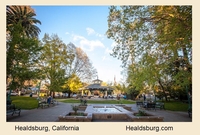 First, Healdsburg, California in the heart of Sonoma County. Healdsburg is surrounded by vineyards, from Chalk Hill to the Dry Creek and Russian River Valleys. This small village with its quaint town square is a beehive of activity during harvest. There are numerous excellent bed and breakfast spots to choose from, but I typically decamp at Hotel Healdsburg with its crackling fireplace in the bar area and exquisite menu offerings at Charlie Palmer’s Dry Creek Kitchen. First, Healdsburg, California in the heart of Sonoma County. Healdsburg is surrounded by vineyards, from Chalk Hill to the Dry Creek and Russian River Valleys. This small village with its quaint town square is a beehive of activity during harvest. There are numerous excellent bed and breakfast spots to choose from, but I typically decamp at Hotel Healdsburg with its crackling fireplace in the bar area and exquisite menu offerings at Charlie Palmer’s Dry Creek Kitchen.
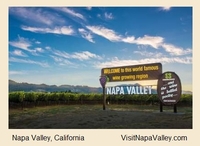 Napa, California is perhaps the busiest destination of them all around harvest. I like to stay at the Rancho Caymus Inn, north of the city in the heart of the Napa Valley. Under the same ownership as the excellent Flora Springs winery, Rancho Caymus features wood-burning fireplaces in nearly every room and is right next door to the iconic Beaulieu Vineyards winery. You can’t get much closer to the harvest as that, with trucks wheeling grapes to the crusher throughout the night. Also next door is the delicious Rutherford Grill, where there is no corkage fee if you bring in your own wine. And not to be missed at harvest is a stop at Chef Ken Frank’s La Toque, a Michelin-starred restaurant in the Westin hotel in the city of Napa. Frank runs a special truffle menu every year during harvest, and if you’re lucky Chef Frank will personally shave truffles at your table. Napa, California is perhaps the busiest destination of them all around harvest. I like to stay at the Rancho Caymus Inn, north of the city in the heart of the Napa Valley. Under the same ownership as the excellent Flora Springs winery, Rancho Caymus features wood-burning fireplaces in nearly every room and is right next door to the iconic Beaulieu Vineyards winery. You can’t get much closer to the harvest as that, with trucks wheeling grapes to the crusher throughout the night. Also next door is the delicious Rutherford Grill, where there is no corkage fee if you bring in your own wine. And not to be missed at harvest is a stop at Chef Ken Frank’s La Toque, a Michelin-starred restaurant in the Westin hotel in the city of Napa. Frank runs a special truffle menu every year during harvest, and if you’re lucky Chef Frank will personally shave truffles at your table.
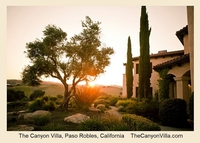 Paso Robles, California is another small California
city with a big winery presence and a charming town square . A patio
table at BL Brasserie (formerly Bistro Laurent) puts you in the middle
of everything, with local wines galore at one of Paso’s most prominent
restaurants over the past two decades. And for a superb dining
experience at a winery, the restaurant at Niner Wine Estates on the west
side of Paso is about as good as it gets. The finest bed and breakfast
around, The Canyon Villa, also is located on the west side. Chef
Wills Carter, the proprietor, won’t disappoint. Chef Carter has
serious game. Paso Robles, California is another small California
city with a big winery presence and a charming town square . A patio
table at BL Brasserie (formerly Bistro Laurent) puts you in the middle
of everything, with local wines galore at one of Paso’s most prominent
restaurants over the past two decades. And for a superb dining
experience at a winery, the restaurant at Niner Wine Estates on the west
side of Paso is about as good as it gets. The finest bed and breakfast
around, The Canyon Villa, also is located on the west side. Chef
Wills Carter, the proprietor, won’t disappoint. Chef Carter has
serious game.
Email Robert at [email protected]
or connect with him on Twitter at @WineGuru
Posted by Robert Whitley at 1:26 PM
|
|
September 17, 2019
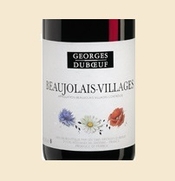 A Georges Duboeuf Beaujolais Villages will set you back
about eleven bucks. The Beaujolais Villages from Maison Louis Jadot can be
found for under ten. A Georges Duboeuf Beaujolais Villages will set you back
about eleven bucks. The Beaujolais Villages from Maison Louis Jadot can be
found for under ten.
Jadot’s more upscale Beaujolais, its Chateau des Jacques
lineup of Beaujolais crus, retails in the low $20 range. Ditto the Beaujolais
crus from Duboeuf. I found the Duboeuf Beaujolais crus Brouilly for $23.
Those who equate price with quality might surmise Beaujolais,
even at the top end, has little to recommend it other than price. I would beg
to differ. Beaujolais is the perfect summer wine.
First and foremost, quality runs very high throughout the
Beaujolais district, situated at the southern tip of France’s Burgundy region. The
vast difference in price between Beaujolais and the red Burgundies of the Cote
d’Or can be attributed to the grapes used in production.
The Cote d’Or Burgundies are made from Pinot Noir, Beaujolais
from gamay. Pinot Noir produces a deeper, more tannic red wine that often
improves dramatically with age. The best can age for decades.
Gamay delivers a lighter, crisper red wine that is delicious
from the moment it is bottled. A few of the crus Beaujolais, particularly from
the villages of Moulin-a-Vent and Morgon, improve with age but for the most
part Beaujolais is a “now” wine.
Its beauty is its freshness. Beaujolais is exceptionally
versatile, as well. In summer months Burgundians serve it chilled. It can be
served with meat or fish, and it is often served at the end of the meal with
cheese. Its innate fruitiness allows it to complement slightly sweet sauces,
while its savory side makes it a strong match for earthy dishes, game birds,
rabbit and, of course, mushrooms.
Even at the villages level, its lowest, the wines tend to be
well balanced and drinkable.
Then there is the price. Delicious wines in the $10 range are
a rare commodity. Except in Beaujolais.
Connect with Robert on Twitter where he tweets as @WineGuru
Posted by Robert Whitley at 10:33 PM
|
|
September 9, 2019
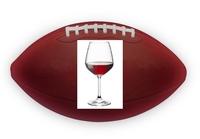 The kickoff of football season always reminds me of burned brats, warm white wine and that sinking feeling when you learn no one remembered to bring a corkscrew. Tailgate parties don’t have to be a disappointing launch to an otherwise glorious autumn afternoon, though they often are. The kickoff of football season always reminds me of burned brats, warm white wine and that sinking feeling when you learn no one remembered to bring a corkscrew. Tailgate parties don’t have to be a disappointing launch to an otherwise glorious autumn afternoon, though they often are.
Over the years I’ve learned a few lessons that I will now share with those inclined to want wine instead of beer at the next tailgate party.
1. Do not fear the screwcap. Stranded and thirsty in a sun-drenched parking lot, the once onerous “scewcap” closure could be your best friend. Screwcap once upon a time was an indication of poor quality. The Aussies and Kiwis changed our thinking when some years ago they started selling many of their finest wines in bottles with screwcap closures. Now everyone does it and the convenience factor when you are camping or tailgating is off the charts. Do not let the absence of a corkscrew spoil your party.
2. Do not fear the tall, slender wine bottles popular in Germany and Austria. Too many wine enthusiasts equate this bottle shape with sweet dessert wines. Not so. Dry Rieslings and Gewurztraminers from stellar producers such as Dutton-Goldfield and Navarro Vineyards are poured from the same type of bottle, and these might well be the best match for your grilled sausages and brats.
3. Do not fear pink wine. Once upon a time most domestic pink wine was sweet and icky. Not so anymore. Domestic producers have embraced Europe’s love of crisp, dry Rosé wines that are both refreshing and oh-so-versatile with just about every savory morsel served up at a typical tailgate gathering.
4. Do not fear high-octane Zinfandel. There is no doubt the average Zinfandel, if it’s made in the bold, ripe style Zin fanatics love, packs a wallop. The alcohol by volume sometimes exceeds 15 percent and most of the time that’s not necessarily good with refined cuisine. But we’re talking tailgate party here. Burgers, steaks, chops, sausages, brats, etc. There is no better red wine for the challenge of the tailgate than Zinfandel. Just remember the three Rs – Renwood, Runquist and Rodney Strong!
Posted by Robert Whitley at 5:03 PM
|
|
 |
|